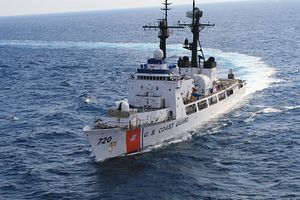To round off the week, a few defense and security links, focusing mostly on naval affairs this week:
The Philippines is looking to purchase a third Hamilton-class high endurance cutter from the United States. “As far as we are now looking at it, there will be a positive action for getting a third Del Pilar frigate as we now call the Hamilton Class cutters,” Navy chief Vice Admiral Jose Luis Alano told Rappler. The decommissioned Hamilton-class frigates BRP Gregorio Del Pilar and BRP Ramon Alcaraz are among the Philippine Navy’s most capable warships today. The Philippines is expected to procure an additional warship to aid in its patrols of the South China Sea, where it attempts to protect its disputed territorial claims from China. Plans to acquire a third Hamilton-class frigate were reported to have been canceled as recently as September 2013.
Thailand may be looking to build a second littoral patrol vessel soon under a license granted by BAE Systems. According to a Defense News report, “discussions are underway for construction of a second warship after a technology transfer deal between BAE and the state-owned shipyard Bangkok Dock resulted in the first of class, HTMS Krabi, being commissioned into the Royal Thai Navy in August 2013.” The ship is expected to be a smaller derivative of the Royal Navy River-class ship. In terms of features, the ship will sport a 76mm Oto Melara gun and a helicopter flight deck “able to operate a machine the size of the AgustaWestland A139 Lynx.” Thailand may consider the ship for export pending negotiations.
Comments by a U.S. General regarding a potential U.S.-Japan retake of the Senkaku/Diaoyu Islands following a Chinese takeover have angered Chinese observers greatly. Marine Corps Lt. Gen. John Wissler, commander of the 18,000 Marines stationed in Okinawa, told reporters that U.S. Marines would be able to swiftly take back the islands should China invade them. He added, “You wouldn’t maybe even necessarily have to put somebody on that island until you had eliminated the threat, so to speak.” That line incensed Chinese observers. The Global Times fired back, saying that “these U.S. warships roaming around here [in the East China Sea] are slowly being considered by us Chinese as our moving targets right in front of our eyes, and the [U.S.] bases in Okinawa as a whole are also no longer a big deal [to us].” It added that “When facing China, these U.S. soldiers are really not worth anything.” “If China and the U.S. were to start an all-out fight, these American Marines would be more like a marching band, charging with others, but with their musical instruments in hands.”
In an article over at CSIS, Phuong Nguyen argues that the United States needs a more coordinated approach to the Lower Mekong region which could be the “next South China Sea.” The issue is part environmental, and part strategic.
As Shannon Tiezzi detailed earlier, Japan’s decision to station a Ground Self-Defense Force contingent on Yonaguni Island — Japan’s westernmost inhabited island — has raised China’s ire.
Xi Jinping is calling for the People’s Liberation Army to integrate its Air Force and space capabilities. The idea of integrating air and space capabilities, of course, is not a novel concept. The United States Air Force declared its intent to treat both as part of one seamless operational spectrum in 2000. Xi also asked the PLAAF to developed a “new-type combat force.”
Finally, Zach and I discuss President Obama’s upcoming trip to Asia on the podcast this week. We also consider recent stabilizing developments in diplomacy between China and Japan, and Japan and South Korea.

































